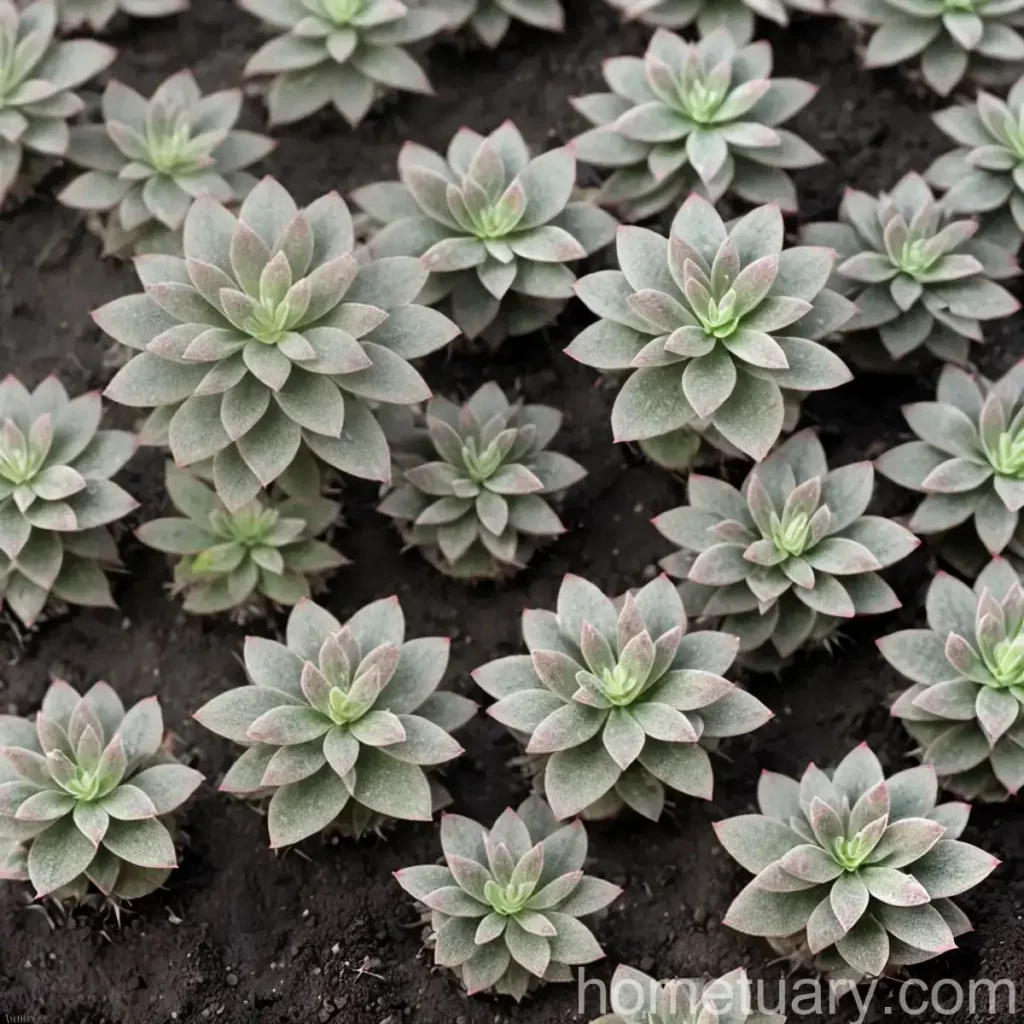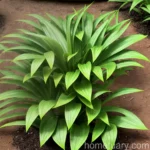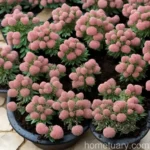Stonecrop (Hylotelephium telephium subsp. ruprechtii ‘Hab Gray’)
Introduction
Stonecrop, scientifically known as Hylotelephium telephium subsp. ruprechtii ‘Hab Gray’, is a succulent plant that belongs to the stonecrop family. With its unique features and versatility, stonecrop has become a popular choice for gardens, landscapes, and container gardening. In this comprehensive guide, we will explore the various aspects of stonecrop, including its culture, uses, care requirements, and much more.
What is Stonecrop?
Stonecrop is a diverse genus of succulent plants native to many parts of the Northern Hemisphere. The name “stonecrop” is derived from the plant’s ability to grow in the thin, rocky crevices of cliffs and rocky ledges. As a member of the Crassulaceae family, stonecrop is characterized by its fleshy, water-storing leaves, making it well-adapted to arid and semi-arid environments.
Stonecrop Varieties
The stonecrop genus encompasses a wide range of species and cultivars, each with its own unique characteristics and growth habits. Some popular varieties of stonecrop include:
- Hylotelephium telephium subsp. ruprechtii ‘Hab Gray’
- Hylotelephium spectabile ‘Brilliant’
- Hylotelephium telephium ‘Autumn Joy’
- Hylotelephium sieboldii ‘Mediovariegatum’
- Hylotelephium ‘Maestro’
Each of these varieties exhibits distinct features, such as flower color, growth habit, and drought tolerance, contributing to the overall appeal of the stonecrop genus.
Key Takeaways
Before delving deeper into the specific aspects of stonecrop, let’s take a look at the key takeaways of this versatile succulent.
Culture
- Stonecrop is a low-maintenance plant that thrives in well-draining soil and full sunlight.
- It is drought-tolerant and requires minimal watering once established.
- Stonecrop can be grown in containers, rock gardens, borders, and even green roofs, making it a versatile addition to various landscapes.
Uses
- Stonecrop serves as an excellent ground cover and can be utilized for erosion control on slopes and hillsides.
- It is an attractive addition to rock gardens, xeriscapes, and Mediterranean-style landscapes.
- Some varieties of stonecrop have medicinal properties and are used in traditional herbal medicine.
Water
- Stonecrop has low to moderate water requirements and is well-suited to dry, arid climates.
- Overwatering can lead to root rot and other issues, so it is essential to allow the soil to dry out between waterings.
Sunlight
- Full sunlight is ideal for stonecrop, as it promotes strong growth and vibrant flower coloration.
- In hot climates, some afternoon shade may be beneficial to prevent leaf scorching.
Fertilizer
- Stonecrop generally does not require heavy fertilization and can thrive in nutrient-poor soils.
- An annual application of a balanced fertilizer in spring can support healthy growth and flowering.
Soil
- Well-draining, sandy loam or rocky soils are best suited for stonecrop cultivation.
- The pH level should be slightly acidic to neutral for optimal growth.
Pruning
- Minimal pruning is needed for stonecrop, primarily to remove dead flower heads and maintain a tidy appearance.
- Pruning can be done in late fall or early spring.
Propagation
- Stonecrop can be propagated from stem cuttings, division of offsets, and seed sowing.
- Stem cuttings root easily and can be taken in spring or early summer.
Container Popularity
- Stonecrop is a popular choice for container gardening, as it adapts well to the confined space of pots and planters.
- It adds texture and visual interest to mixed container arrangements.
Container Common Diseases
- Overwatering in containers can lead to fungal diseases such as root rot and powdery mildew.
- Proper drainage and appropriate watering practices can help prevent these issues.
Disease Diagnosis
- Common diseases affecting stonecrop include fungal infections, particularly in humid or poorly ventilated conditions.
- Regular inspection of the plant for signs of discoloration, wilting, or unusual growth can aid in early diagnosis and treatment.
Common Pests
- Aphids, mealybugs, and spider mites are potential pests that can affect stonecrop plants.
- Natural predators, such as ladybugs and lacewings, can help control pest populations.
Botanist’s Tips
- When selecting a stonecrop variety for your garden or landscape, consider factors such as mature plant size, flower color, and foliage texture.
- Incorporate stonecrop alongside other drought-tolerant plants for a cohesive and water-wise landscape design.
Fun Facts
- Due to their ability to withstand harsh environmental conditions, stonecrop plants are often used in green roof installations to provide insulation and stormwater management benefits.
- The name “stonecrop” is believed to have originated from the Old English term “stonecroppe,” referring to the plant’s growth habit in rocky habitats.
Links to External Resources
For additional information on stonecrop, you can explore the following resources:
1. The Royal Horticultural Society – Stonecrop Plant Guide
2. Missouri Botanical Garden – Hylotelephium telephium subsp. ruprechtii ‘Hab Gray’
3. United States Department of Agriculture – Natural Resources Conservation Service – Stonecrop
Now that we have covered the key takeaways, let’s delve into the details of stonecrop care, characteristics, and more.
Stonecrop Plant Characteristics
Plant Family
Stonecrop belongs to the Crassulaceae family, which is known for its diverse and often succulent plant species. The family includes a wide range of genera, such as Sedum, Echeveria, and Kalanchoe, all of which exhibit fleshy leaves and unique growth habits.
Plant Species
The species Hylotelephium telephium encompasses various subspecies and cultivars, each with distinct characteristics. ‘Hab Gray’ is a specific cultivar known for its compact growth habit and attractive foliage and flowers.
Plant Health Benefits
Stonecrop possesses several health benefits, primarily in traditional herbal medicine. The plant is believed to have anti-inflammatory and wound-healing properties, and its extracts are used in various medicinal preparations.
Drought Tolerance
One of the most notable characteristics of stonecrop is its exceptional drought tolerance. The plant’s succulent leaves store water, allowing it to withstand extended periods of drought with minimal moisture requirements.
Low-Maintenance Plant
For gardeners and landscapers seeking low-maintenance options, stonecrop is an excellent choice. Its adaptability to different soil types and minimal care requirements make it a hassle-free addition to various outdoor settings.
Ground Cover
Many stonecrop varieties function as an effective ground cover, forming dense mats of foliage that suppress weed growth and provide visual interest throughout the growing season.
Garden Plant
In garden settings, stonecrop adds a unique texture and form to borders, rockeries, and mixed perennial beds. Its ability to thrive in challenging conditions makes it suitable for diverse garden styles.
Medicinal Properties
Certain species of stonecrop have been used in traditional medicine to treat minor skin irritations, burns, and other topical ailments. Research on the medicinal properties of stonecrop continues to unveil potential applications in modern healthcare.
Flowering Season
Stonecrop typically blooms in late summer to fall, producing clusters of star-shaped flowers in shades of pink, red, white, or a combination of these colors. The late-season bloom adds a welcome burst of color to the landscape.
Uses
Apart from its ornamental value, stonecrop has been traditionally used for various purposes, including erosion control, roofing materials, and even as a food source in some cultures.
Symbolism
In some cultures, stonecrop is associated with symbolism related to adaptability, resilience, and endurance. Its ability to thrive in austere environments has led to its representation in folklore and traditions.
Anatomy
The anatomy of stonecrop plants includes succulent leaves with specialized water-storing cells, fleshy stems, and clusters of flowers borne on sturdy stems. The inflorescences are often attractive to pollinators, further benefiting the local ecosystem.
Adaptations
Evolutionary adaptations have shaped stonecrop plants to survive in challenging environments, including developing water-storing tissues, succulent leaves, and reproductive strategies suited to their natural habitats.
Natural Habitat
Stonecrop species are native to a wide range of habitats, including dry grasslands, rocky outcrops, mountain slopes, and coastal cliffs. Their distribution spans across diverse climatic regions, from temperate to subarctic zones.
Landscape Design Ideas
In landscape design, stonecrop can be utilized in various ways, such as creating living walls, lining pathways, and accentuating dry stream beds. Its versatility and visual appeal make it a valuable addition to landscape compositions.
Plant Colors
The foliage of stonecrop plants ranges from blue-green to gray-green, and some varieties exhibit seasonal color changes, such as reddish hues in winter. The flowers contribute additional color diversity with their vibrant shades.
Photosynthesis
As succulent plants, stonecrop species are adapted to efficiently carry out photosynthesis, utilizing specialized adaptations to minimize water loss while maximizing carbon dioxide uptake for organic synthesis.
Growth Stages
Stonecrop plants progress through distinct growth stages, including emergence in spring, vegetative growth, flowering, seed production, and dormancy in winter. Understanding these stages aids in optimal care and maintenance.
Companion Plants
When selecting companion plants for stonecrop, consider species that share similar water and light requirements, such as other succulents, ornamental grasses, and drought-tolerant perennials. This approach creates harmonious plant associations in the garden.
Pests and Diseases
While stonecrop is generally resistant to many pests and diseases, occasional issues with aphids, mealybugs, and fungal infections can arise. Vigilant monitoring and timely intervention help maintain plant health.
Fertilization
Stonecrop’s minimal fertilizer needs make it an easy-to-manage plant in garden settings. A light application of balanced fertilizer in spring suffices to support healthy growth and flowering.
Pruning Techniques
Pruning is primarily performed to remove spent flower heads and maintain an attractive plant shape. Prune the stems back to the basal rosettes or just above newly emerging side shoots to encourage bushy growth.
Decorative Uses
Stonecrop’s unique form and texture make it an excellent addition to mixed floral arrangements, wreaths, and botanical crafts. The fleshy leaves and flowers contribute to the visual appeal of decorative compositions.
Ground Cover Alternatives
In landscaping, stonecrop serves as an excellent alternative to traditional ground covers, offering drought tolerance, erosion control, and aesthetic value. It is particularly well-suited for challenging areas with poor soil and limited moisture.
Hardiness Zones
Stonecrop species are adaptable to a wide range of hardiness zones, encompassing regions with differing winter temperature extremes. Selecting varieties suited to the specific hardiness zone is crucial for successful cultivation.
Wildlife Attraction
The nectar-rich flowers of stonecrop attract pollinators such as bees, butterflies, and hummingbirds, contributing to the diversity and vitality of the local ecosystem. Consider incorporating stonecrop in wildlife-friendly garden designs.
Winter Care
In colder climates, stonecrop benefits from a layer of mulch to protect the root zone from freezing temperatures. Mulching also helps moderate soil moisture levels during winter dormancy.
Sunlight Requirement
Full sunlight is essential for promoting robust growth and flowering in stonecrop plants. Adequate sunlight exposure encourages compact growth and vibrant foliage colors.
Water Requirements
Stonecrop’s water needs are relatively low, particularly once the plants are established. Avoid overwatering, as it can lead to root rot and other moisture-related issues.
Soil Preferences
Well-draining soil with a sandy or rocky texture is ideal for stonecrop cultivation. The soil should not retain excess moisture or become waterlogged, as this can harm the plant’s root system.
Propagation Methods
Stonecrop can be propagated through various methods, including division, stem cuttings, and seed sowing. Each approach offers unique advantages and is suited to different growing conditions and timelines.
Pollination Process
The pollination of stonecrop flowers is primarily facilitated by bees, butterflies, and other pollinators attracted to the nectar and vibrant blooms. Pollination results in seed production and genetic diversity within the species.
Blooming Period
Stonecrop plants typically bloom from late summer to fall, adding a late-season burst of color to the landscape. The extended flowering period contributes to their ornamental value and ecological role in supporting pollinators.
Seasonal Changes
Stonecrop exhibits seasonal changes in leaf color, growth rate, and flowering pattern, responding to environmental cues such as temperature and day length. Understanding these seasonal dynamics aids in successful plant care.
Common Names
Stonecrop is known by various common names in different regions, reflecting its widespread cultivation and historical significance in traditional herbal medicine and horticulture.
Native Origins
The native origins of stonecrop span across Europe, Asia, and North America, where different species and varieties have adapted to diverse ecological niches and climatic conditions.
Hybrid Varieties
Breeding efforts have led to the development of numerous hybrid stonecrop varieties with enhanced flower colors, compact habits, and improved disease resistance, expanding the diversity of options for gardeners.
Endangered Status
While many stonecrop species are not classified as endangered, certain rare or localized populations face habitat loss and conservation challenges. Efforts to protect native habitats are crucial for safeguarding the diversity of stonecrop species.
Edging Options
Stonecrop’s low-growing and spreading habit makes it well-suited as an edging plant for borders, pathways, and rock gardens. Its ability to thrive in challenging conditions adds visual appeal to edging installations.
Evolution History
The evolutionary history of stonecrop species is intertwined with ecological shifts, climate change, and adaptation to new habitats. Studies of stonecrop’s genetic diversity and evolutionary relationships shed light on its evolutionary trajectory.
Ground Stability Benefits
As a ground cover, stonecrop contributes to the stability of slopes, hillsides, and rocky terrains, helping prevent soil erosion and landslides. Its dense root system and low-growing habit contribute to soil retention and stabilization.
Geographical Distribution
Stonecrop’s geographical distribution encompasses a wide range of climates, from coastal regions to high-altitude mountain habitats. Its adaptability to diverse environments has contributed to its widespread distribution across continents.
Conclusion
Stonecrop, with its resilient nature, ornamental appeal, and ecological value, holds a distinct place in the world of horticulture and landscape design. By considering its culture, uses, care requirements, and unique characteristics, gardeners and plant enthusiasts can explore the diverse potential of stonecrop in various settings. Whether used as a ground cover, container plant, or garden specimen, stonecrop embodies adaptability and visual charm, enriching landscapes and supporting biodiversity.
Incorporating stonecrop into landscape designs offers an opportunity to celebrate its ecological contributions, cultural symbolism, and horticultural significance. As we continue to appreciate the diversity of plant life and seek sustainable gardening practices, stonecrop stands out as a resilient and versatile addition to outdoor environments.
By understanding its growth habits, environmental preferences, and seasonal changes, we can cultivate stonecrop with confidence and creativity, integrating this distinctive succulent into our gardens, landscapes, and green spaces. As we embrace the beauty and resilience of stonecrop, we honor its role in horticulture, ecology, and cultural traditions, ensuring that its legacy endures for generations to come.
References
- The Royal Horticultural Society – Stonecrop Plant Guide. https://www.rhs.org.uk/plants/100130/i-hylotelephium-telephium-i-subsp-i-ruprechtii-i-hab-gray/details
- Missouri Botanical Garden – Hylotelephium telephium subsp. ruprechtii ‘Hab Gray’. https://www.missouribotanicalgarden.org/PlantFinder/PlantFinderDetails.aspx?taxonid=267225&isprofile=0&
- United States Department of Agriculture – Natural Resources Conservation Service – Stonecrop. https://plants.sc.egov.usda.gov/plantguide/pdf/pg_hyte2.pdf















